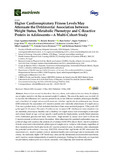Mostrar el registro sencillo del ítem
Higher cardiorespiratory fitness levels may attenuate the detrimental association between weight status, metabolic phenotype and C-reactive protein in adolescents—a multi-cohort study
| dc.creator | Agostinis-Sobrinho, César | es_ES |
| dc.creator | Rosário, Rafaela | es_ES |
| dc.creator | Izquierdo Redín, Mikel | es_ES |
| dc.creator | García Hermoso, Antonio | es_ES |
| dc.creator | Ramírez Vélez, Robinson | es_ES |
| dc.date.accessioned | 2020-08-05T06:00:34Z | |
| dc.date.available | 2020-08-05T06:00:34Z | |
| dc.date.issued | 2020 | |
| dc.identifier.issn | 2072-6643 | |
| dc.identifier.uri | https://hdl.handle.net/2454/37671 | |
| dc.description.abstract | Results from several studies show that only obese, unfit subjects, but not obese, fit subjects, are at higher mortality risk than are normal-weight fit subjects. The aim of the study was two-fold: (1) to examine the differences in C-reactive protein levels across different metabolic phenotypes (healthy and unhealthy) of weight status and (2) ascertain whether high levels of cardiorespiratory fitness (CRF) attenuate the association of C-reactive protein and metabolic phenotypes of weight status. This was a pooled study, which included data from three cross-sectional projects (1706 youth (921 girls) aged 12–18 years). We used a Shuttle run test to assess CRF. Adolescents were classified into six metabolic phenotypes (healthy and unhealthy) of weight status (non-overweight, overweight and obese), based on age-and sex-specific cutoff points for triglycerides, systolic blood pressure, HDL-cholesterol, glucose and body mass index. High-sensitivity assays were used to obtain the C-reactive protein as inflammatory biomarker. After adjustment for potential confounders (age, sex, pubertal stage and country), the analysis of covariance (ANCOVA) shows that C-reactive protein is directly associated with metabolic phenotypes of weight status. Subjects with obesity, regardless of their metabolic profile, had higher levels of C-reactive protein Z-score. In addition, (after adjustments for potential confounders) a two-way ANCOVA showed that high levels of CRF attenuated the associations of C-reactive protein levels in metabolic healthy nonoverweight and in adolescents with obesity. In conclusion, higher CRF levels may attenuate the detrimental association between obesity and C-reactive protein independently of metabolic phenotype. Findings from this study are important for prevention, clinical practice on issues associated with adiposity and metabolic disorders. | en |
| dc.description.sponsorship | The Research Centre on Physical Activity Health and Leisure (CIAFEL) is supported by UID/DTP/00617/2013 (FCT). R.S. has a Discovery Early Career Research Award from the Australian Research Council (DE150101921). The FUPRECOL Study was carried out with the financial support of Instituto Colombiano para el Desarrollo de la Ciencia y la Tecnología 'Francisco José de Caldas' COLCIENCIAS (Contract Nº 671-2014 Code 122265743978). This study was funded by the Department of Education (Grand number: CENEDUCA1/2019) of the Government of Navarra (Spain). A.G.-H. is a Miguel Servet Fellow (Instituto de Salud Carlos III—CP18/0150). R.R.-V. is funded in part by a Postdoctoral Fellowship Resolution ID 420/2019 of the Universidad Pública de Navarra. | en |
| dc.format.extent | 11 p. | |
| dc.format.mimetype | application/pdf | en |
| dc.language.iso | eng | en |
| dc.publisher | MDPI | en |
| dc.relation.ispartof | Nutrients, 2020, 12 (5), 1461 | en |
| dc.rights | © 2020 by the authors. Licensee MDPI, Basel, Switzerland. This article is an open access article distributed under the terms and conditions of the Creative Commons Attribution (CC BY) license. | en |
| dc.rights.uri | https://creativecommons.org/licenses/by/4.0/ | |
| dc.subject | Metabolic | en |
| dc.subject | Healthy | en |
| dc.subject | Obese | en |
| dc.subject | Aerobic | en |
| dc.subject | Fitness | en |
| dc.subject | Inflammation | en |
| dc.subject | Youth | en |
| dc.title | Higher cardiorespiratory fitness levels may attenuate the detrimental association between weight status, metabolic phenotype and C-reactive protein in adolescents—a multi-cohort study | en |
| dc.type | info:eu-repo/semantics/article | en |
| dc.type | Artículo / Artikulua | es |
| dc.contributor.department | Ciencias de la Salud | es_ES |
| dc.contributor.department | Osasun Zientziak | eu |
| dc.rights.accessRights | info:eu-repo/semantics/openAccess | en |
| dc.rights.accessRights | Acceso abierto / Sarbide irekia | es |
| dc.identifier.doi | 10.3390/nu12051461 | |
| dc.relation.publisherversion | https://doi.org/10.3390/nu12051461 | |
| dc.type.version | info:eu-repo/semantics/publishedVersion | en |
| dc.type.version | Versión publicada / Argitaratu den bertsioa | es |
| dc.contributor.funder | Gobierno de Navarra / Nafarroako Gobernua, CENEDUCA1/2019 | es |
| dc.contributor.funder | Universidad Pública de Navarra / Nafarroako Unibertsitate Publikoa | es |



